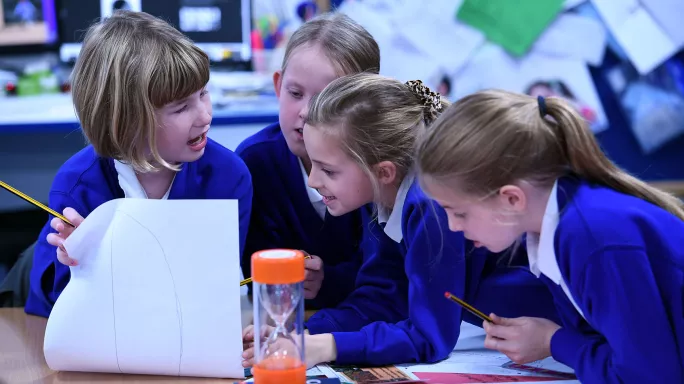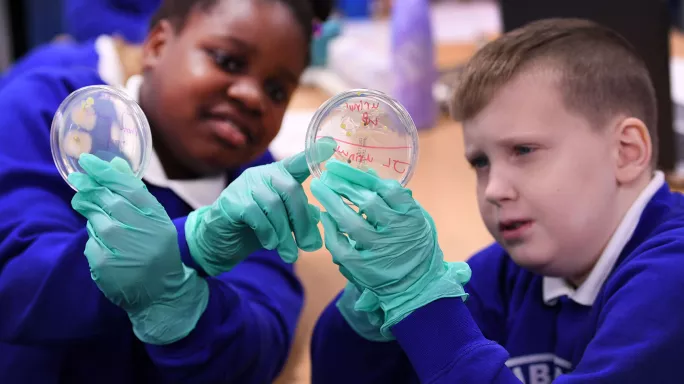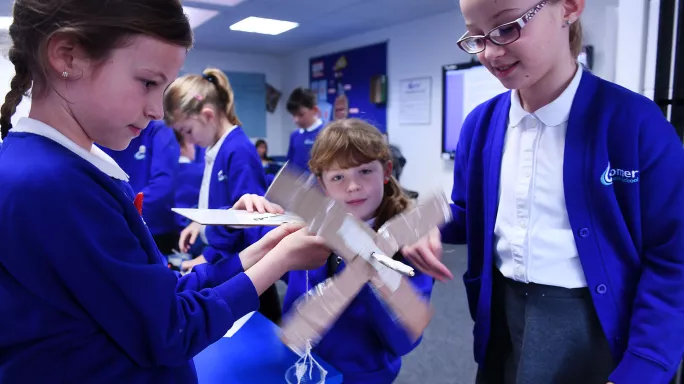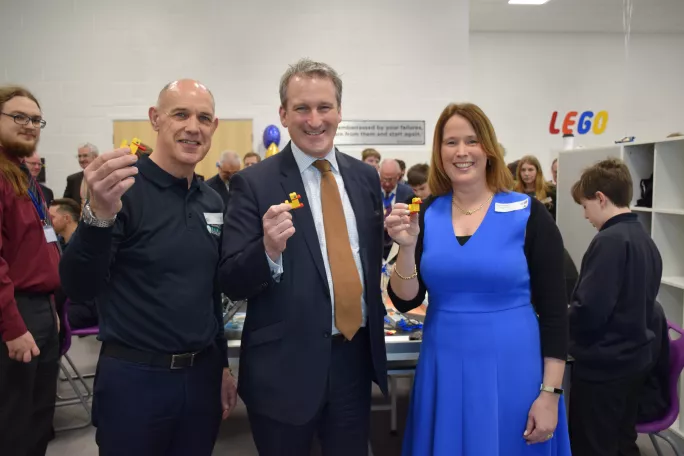- Home
- How to deliver great Stem without spending a fortune
How to deliver great Stem without spending a fortune

What links pumpkin seeds, the national currency of Bangladesh, and a class of Year 3 pupils on the south coast of England?
The answer is a gSTEM, a pioneering approach to science, technology, engineering and maths which saw Gomer Junior School in Gosport, near Portsmouth, named science, technology and engineering teacher or team of the year as the Tes Schools Awards in 2018.
The school believe that by treating Stem as an ethos it is possible to give the subject the commitment it deserves, despite pressures that have other primaries prioritise English and maths above all else.
Tes awards: The school of the year 2018
Tes awards: 'Maths geek' made her subject cool
Tes awards: How edtech can motivate all your pupils
And in an age of well-publicised funding pressures facing schools, Gomer believes that delivering it as a vibrant, fulfilling Stem curriculum is possible without breaking the bank.
It is an approach that has helped the school attract the attention of education secretary Damian Hinds and schools minister Nick Gibb, who have both visited, and far from resting on its laurels, the school and its academy trust are making a very concrete commitment to making this a long-term approach.
Schools might have a Stem Day, but so what?
The school’s enthusiastic executive head is Georgina Mulhall, and she traces the commitment to gSTEM to well-publicised concerns in 2015 about the shortage of engineers, particularly women.
“We identified that perhaps our curriculum could provide more opportunities to develop that, we thought we would provide our own Stem curriculum, but using the concept iStem+, and that came from our Stem ambassador, Professor Adrian Oldknow,” she says.
The ‘i’ in ‘iStem+’ stands for ‘integrated’, to ensure that Stem is genuinely incorporated into the curriculum, while the ‘+’ symbolises how the subject is given a real-world context, often through partners in industry.

“We know that a lot of schools might have a Stem Day or Stem Week, but actually it’s like ‘so what?’ It needs to be more than that.”
The result was gSTEM – Gomer Stem – which launched in September 2015, with a whole-school model.
It was a time of excitement about Tim Peake’s imminent trip into space and a new Star Wars film, so the school’s first project involved challenging pupils to create a self-propelled space buggy that could move over the different terrains of one of the planets from the movie.
'We didn’t hide that we were having to learn new stuff'
The new approach sees integrated Stem teaching replace English, maths and science for one morning a week.
Gomer was careful to communicate clearly with parents about the change, and worked hard to ensure all teachers were on board.
“Team Gomer is a really cohesive, innovative team,” Mulhall says, “so they were really happy to adopt something new.
“For colleagues who were perhaps a little bit more apprehensive because it was going to take them out of their comfort zone, or perhaps they didn’t have significant buy-in because it was new, we had monthly training.
“They weren’t attended by myself or the deputy at the time, so it really was open dialogue and learning.”
There was, she says, a clear plan for each training session, including what could be learned from the previous month, and what would happen in the month to come.

For the executive head, being open about this learning process has been of clear benefit.
“That’s been really positive for the children because we didn’t hide that we were having to learn new stuff as well, and that can actually enable the children to know that we don’t know everything, and it’s OK not to know everything.
“Where we have been challenged to have to include GCSE [content] in physics [lessons], it’s one thing to pass GCSE, it’s another thing to teach it, but because the children recognise that we were learning with them at times, I think that added to the buy-in.”
And the decision to place the Stem session in the morning rather than afternoon was a tactical choice to show the importance the school attached it.
Talking torque
When Tes visits, the weekly Stem morning is in full swing across the school.
Pupils in Year 3 have been growing pumpkin seeds, one of the fruits grown in Bangladesh, and thinking about vitamins that they provide.
In the lesson, they use the taka, the national currency, to consider how to balance the need to buy rice with the need to buy charcoal to cook it with. But what about the weather? If rainy season is approaching, do they need to repair a leaky roof as well?
In Year 6, pupils are learning about bacteria through the results of swabs they have taken from different places around the school. In the lesson, they excitedly compare the results for mobile phones to toilet handles, and washed hands to unwashed hands.

The lesson is then linked back to questions about clean water in Kenya, water filtration systems, and whether to make them out of plastic.
And the way Year 4 is learning about wind turbines neatly illustrates the school’s approach to teaching Stem.
The turbines are part of a longer-term project about sustainability, and in the previous lesson pupils were creating wind blades. Through their designs, the issue of torque arose.
Although it was not in the original lesson plan, the teacher changed her plan for the following lesson to cover the topic.
The sustainability project was originally planned to last half a term, but if the content demands longer the school is happy for it to spill over into the next half term.
'You can think about things in the future that could help'
gSTEM is an approach that pupils at the junior school seem to enjoy.
Alexander, eight, has been measuring the different lengths of wind turbines and their blades. “I enjoy it because it’s lots of mixed fun lessons together into one big lesson,” he says.
And his classmate Wendy, nine, is clear how the wind turbines lesson fit into a bigger picture: “We are studying electricity and we are trying to reduce the use of electricity because of CO2,” she says.

One Year 6 pupil, Jacob, has a unique perspective from which to consider gSTEM, having recently arrived from another school that did not have the same approach. He is convinced that his friends at his old school would love it.
“I think it’s amazing. You learn things about practical things like helping the environment and then you can also think about things in the future that could help.”
And his classmate Toby, 10, is clear how Stem fits into his career plans.
“I want to be a pilot or in the army,” he says. “I want to help people. Sometimes you save people from diseases in the army. If someone’s wounded you can save them.
“When I’m 14 I want to go to UTC Portsmouth. I’ve visited, and it’s all about Stem. It’s a great college and it’s very hard to get into.”
'It doesn't have to be expensive'
Gomer is evangelical about its approach to Stem, and when the Royal Academy of Engineering published its report Learning to be an Engineer in March 2017, Gomer was a case study for other schools to learn from.
But it is easy to anticipate a big objection that other primary schools might raise when considering whether to adopt the gSTEM approach: money.
Mulhall isn’t buying it.
“It doesn’t have to be expensive,” she insists. “I would say that we are really home-made often in a lot of our approaches.
“In a lot of what we have done we have just used what I think would be considered typical resources in a primary school, and we have built on that in terms of introducing our 3D printer and lots of our tech such as our spheros and things like that.
“But we have just used some of the curriculum budget to deliver that, and then we have been creative in tapping into funding streams.
“Our Stem curriculum resources are not outrageously expensive, and they don’t need to be, so don’t let it be a barrier to starting. Start it, and then you build up your resources, as you would in any area of the curriculum.”
Another potential objection is that the focus schools have to put on English and maths leaves little room for Stem.
For Mulhall, it’s all about your mindset.
“Because we have an integrated curriculum we can enable the curriculum we have to teach through our iStem+ curriculum, so we are not doing extra.
“That’s what we always say: we look at Stem as an ethos as opposed to a curriculum. That’s probably a better way of looking at it.
“By accepting it as an ethos and adopting the engineering habits of mind, for example, those are relevant regardless of however you are going to apply yourself in a curriculum or whatever job you are going to go on to do.”
Inspiring reluctant learners
In March, education secretary Damian Hinds opened the school’s new Stem Centre, which it built within a sport hall complex.
“As a primary we don’t have subject specific learning spaces, so to enable the curiosity and engagement and opportunities we wanted to have a dedicated Stem space. That was the initial idea,” Mulhall says.

Funded through sponsorship, it has been designed as a multi-user space that can accommodate age groups from early years to adults.
As examples of its potential use, Mulhall gives Lego therapy sessions, enrichment activities, teacher training or a venue for local industry to train apprentices.
The mere creation of the Stem Centre is very physical embodiment of the school’s commitment to the subject.
Mulhall says: “By creating that space, it’s communicating to the students, parents and carers that we really value this, and so this is why we have invested in this area.
"Perhaps for those children who are maybe reluctant to participate in Stem, if they can be inspired by a dedicated learning space then that will hopefully impact on outcomes.”
It is clear that Gomer Junior School’s commitment to Stem is there for the long term.
Keep reading for just £1 per month
You've reached your limit of free articles this month. Subscribe for £1 per month for three months and get:
- Unlimited access to all Tes magazine content
- Exclusive subscriber-only stories
- Award-winning email newsletters



